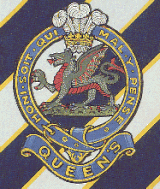Operational deployments
The deployment of the regiment's battalions was primarily to Northern Ireland on Operation Banner during The Troubles, taking part in anti-terrorist operations. The 1st Battalion was almost continuously deployed there between August 1969 and November 1976. [8] The Longest Stag, a recent publication, provides a very detailed account of The Queen's Regiment deployed to Northern Ireland over more than 30 years. In all, twenty-nine operational tours were served by the Regiment. [9]
In 1968, the 2nd Battalion took over Palace Barracks, Belfast, Northern Ireland, from the 4th Battalion (Middlesex) who had been there since 1965. the battalion was engaged in Internal Security duties prior to and at the start of the official declaration of emergency in August 1969. [8] In August 1969 the 1st Battalion were deployed to Derry. [8] The 3rd Battalion were posted to Ballykinler, Northern Ireland in 1970. The 1st Battalion joined the Berlin Brigade in West Berlin, a small enclave in Communist-controlled East Germany. [8] The 4th Battalion was disbanded that year, as with every other 'junior' battalion of the new large regiments. [8]
The 2nd Battalion were deployed to East Belfast in 1971. The 3rd battalion remained in Ballykinler, until they moved to Tidworth in December that year. [8] Both the 2nd and 3rd battalions were deployed on operations to Belfast and Derry, Northern Ireland in 1972 and were involved in Operation Motorman. The 3rd Battalion was posted to Cyprus as part of the United Nations Peacekeeping Force in Cyprus (UNIFICYP), a force intended to prevent conflict from breaking out between Greek and Turkish Cypriots: the battalion returned to the United Kingdom in May 1973. [8] Also that year, the 3rd Battalion arrived in Gibraltar where it remained with the garrison for almost two years. [8]
1st Battalion served in West Belfast between 1973 and 1974 and then again whilst on spearhead in May 1974 for the Ulster Workers Council Strike [8] The 2nd Battalion was posted to Derry, Northern Ireland from Werl, West Germany. [8] In 1975, 1st Battalion was posted to Werl, Germany (replacing the 2nd Battalion – who had moved from Werl back to Bulford Camp). [8]
The 2nd Battalion, were deployed to Northern Ireland in 1976, first on a spearhead deployment in South Armagh following the Kingsmill (Bessbrook) massacre, followed by a 6-month tour in Belize. The 1st Battalion were again deployed to Derry. [8] The 2nd Battalion were deployed to West Belfast, on an operational tour in Andersonstown in early 1977. [8] The 2nd Battalion were then posted to Gibraltar. [8]
The 3rd Battalion were posted to Belize from February to August 1977, then a British territory, as part of the garrison there to protect it from the perceived threat of war with Guatemala, a neighbour of Belize, which was making claims that it believed Belize to be an integral part of Guatemala. [8] In 1978, 1st Battalion deployed on operations to West Belfast for five months from Werl. The 2nd Battalion were in Gibraltar and the 3rd Battalion in Dover. [8] The 3rd Battalion deployed to Bessbrook, Northern Ireland in 1979. [8]
The 1st Battalion moved to Canterbury (the regiment's home base) in 1980. [8] From there it undertook a six-month tour of Belize. [8] The 2nd Battalion deployed to Cyprus on a 6-month tour-of-duty with UN forces in 1981. [8] The 1st Battalion were posted to Omagh in County Tyrone in 1982. [8] It served there until January 1985 with south east Fermanagh as its primary focus. [8] In 1983, the 2nd Battalion were posted to Derry, also on a two-year tour. [8]
The 3rd Battalion were deployed to Belfast on a six-month tour from Fallingbostel in 1984. [8] With all three battalions' in the province of Northern Ireland, A freedom parade was held in Belfast in 1984 at which all three battalions' Regimental Colours were paraded. [10]
The 1st battalion moved to Gibraltar in 1985 for two years before returning to the United Kingdom (Tidworth) in 1987 where it was to remain until 1990. [8] During this period it undertook two 6-month tours of Northern Ireland – South Armagh in 1987 and Belfast in 1989/90. [8] In 1990 the battalion moved to Minden in Germany, where it disbanded in 1992. [8]
The 3rd Battalion deployed to Belize from April to October 1986 on a 6-month tour-of-duty. Whilst there, a company group were on immediate standby to fly to the Turks and Caicos Islands in deterrence to the unrest in July 1986. [11] On behalf of the Battalion the CO, Lt Col Bob McGhie was presented with the Wilkinson Sword for Peace prize for their efforts in Belize, by the Lord Lieutenant of Kent Mr Robin Leigh Pemberton. [12] In 1987 the battalion was deployed to Northern Ireland as a Spearhead unit on Operation Cara Cara, reinforcing existing Units as an incremental Battalion deploying to fifteen base locations across the province with the mission to protect RUC Police stations. [13] In 1988 they returned to Aldergrove, Northern Ireland for a 2-year operational tour. [8] In 1990 the 3rd Battalion arrived in Cyprus—its last deployment abroad and the location of its disbandment in 1992. From Cyprus the Battalion also deployed a reinforced company group for 5 months to the Falkland Islands and South Georgia. [8] The 2nd Battalion were deployed to Falkland Islands and South Georgia in 1985/1986 as part of the joint force garrison to deter an invasion from Argentina. 1988 The 2nd Battalion returned to West Belfast. In 1991 a reinforced infantry company group from the battalion returned to The Falkland Islands and South Georgia. The 2nd Battalion's last operational deployment was to Northern Ireland on Operation Gypsy in 1992 before heading to Canterbury, England where it disbanded later in the year. [8]
